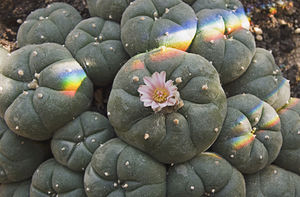We need you! Join our contributor community and become a WikEM editor through our open and transparent promotion process.
Mescaline
From WikEM
Contents
Background
- Psychedelic phenethylamine , naturally occurring in peyote and other cacti
- Similar to, but chemically distinct from and less potent than LSD
- Thought to be a serotonin agonist
- Sold as dried cactus parts or "buttons"
- Used in religious ceremonies by some indigenous Central and South american peoples.
Clinical Features
- Onset 30-60 minutes, lasts 5-12 hours (though wide individual variability)
- Euphoria, energy, esoteric/spiritual experiences
- Altered sensorium, altered sense of time, extreme focus or distractibility, hallucinations
- Nausea/vomiting, abdominal pain
- Adrenergic stimulation: mydriasis, mild tachycardia, mild hypertension, hyperthermia
- Dizziness, headache
Differential Diagnosis
Hallucinogens
- LSD
- 25C-NBOMe
- Phencyclidine
- Mescaline (Peyote)
- Psilocybin/Mushroom Poisoning
- N,N-Dimethyltryptamine
- Ecstasy (MDMA)
- PCP
- Bath Salts
- Salvia toxicity
- Marijuana
- Absinthe
Dissociative drugs
- Dextromethorphan
- Ketamine
- Nitrous oxide
- Phencyclidine (PCP)
- Alcohol Withdrawal
- Anticholinergic Toxicity
- Tricyclic (TCA) Toxicity
- Ertapenem Toxicity
- Encephalitis
- Hypocalcemia/Hypercalcemia
- Schizophrenia, schizo-affective Disorder
- Dementia
- Delirium
- Migraine
- Seizure
- Parkinson's Disease
Evaluation
- Not detected on routine drug screens
- Evaluate for other organic causes of hallucinations or hyperadrenergic symptoms
- Evaluate for co-ingestions
Management
- Supportive care
- Not usually associated with significant morbidity/mortality

